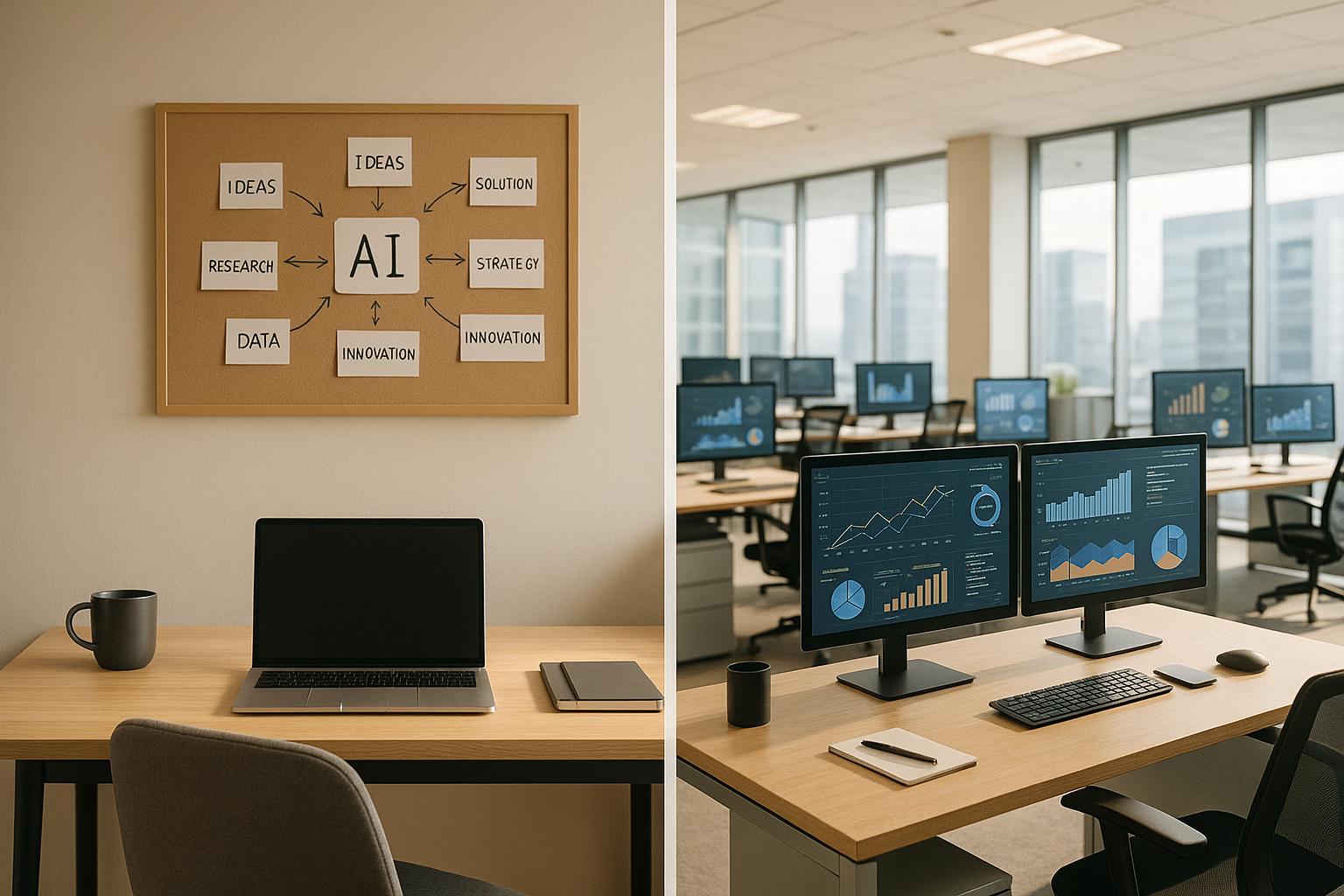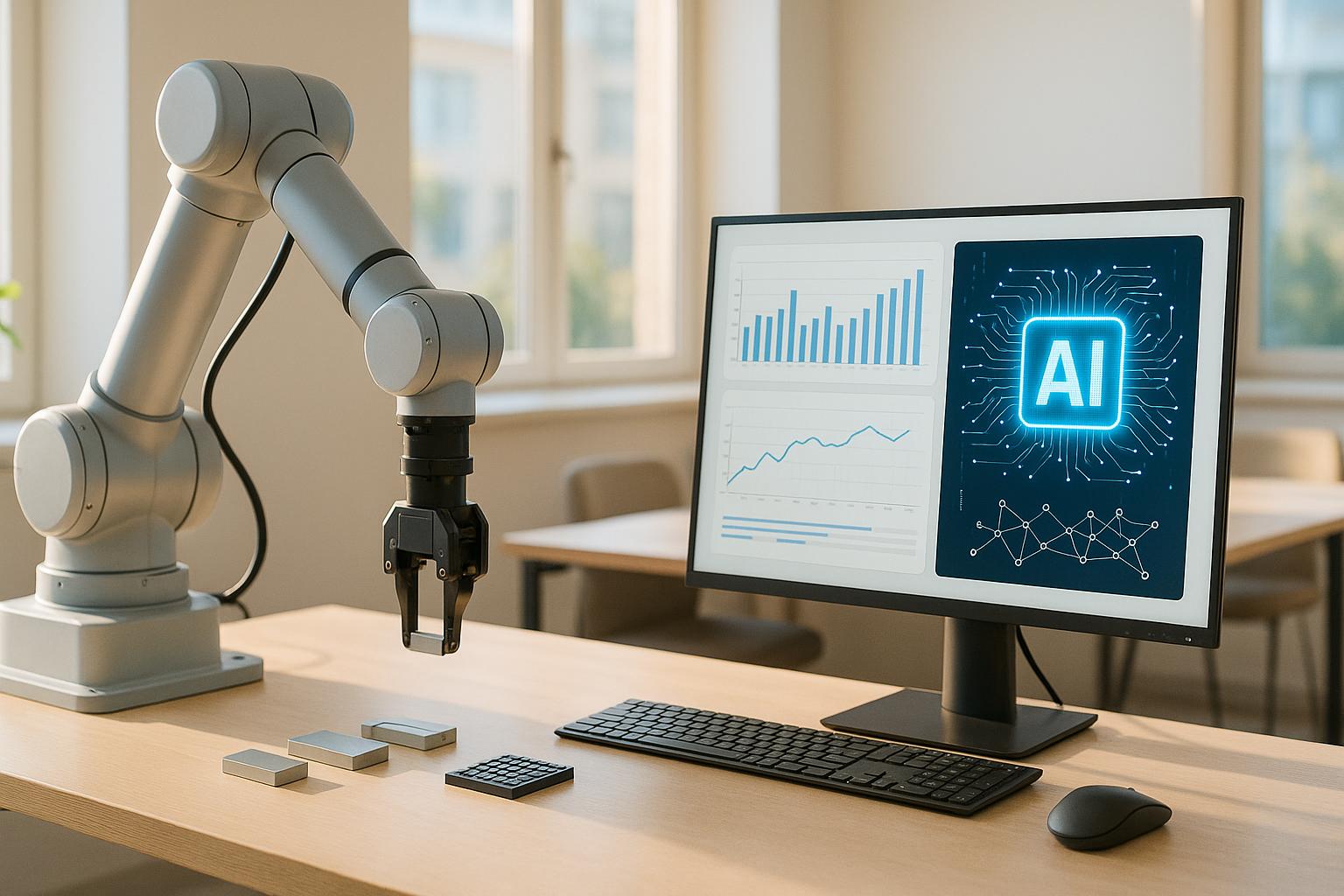Managing employee schedules can be challenging, especially with labor costs, compliance requirements, and last-minute changes. AI-powered scheduling tools are transforming how businesses handle workforce planning by automating processes, improving productivity, and ensuring compliance with labor laws. From predictive analytics to real-time adaptability, these tools cater to industries like healthcare, hospitality, retail, and more. Here's a quick look at the top 10 AI scheduling tools:
- Mesh AI: Predictive scheduling with compliance alerts and seamless HR/payroll integrations.
- RosterLab: Tailored for complex industries like healthcare, focusing on compliance and safety.
- Zendesk: Offers staffing insights through analytics, though not a dedicated scheduling tool.
- Humanity Schedule: Automates scheduling while managing labor costs and compliance.
- Deputy: Combines AI scheduling with mobile access and compliance tracking.
- 7shifts: Designed specifically for restaurants, with overtime alerts and break management.
- When I Work: Simplifies scheduling for small to medium-sized teams with strong integrations.
- Connecteam: Focused on deskless workers, offering auto-scheduling and compliance checks.
- QuickBooks Time: Integrates with QuickBooks for time tracking and payroll processing.
- Sling: Streamlines scheduling and team communication with compliance monitoring.
These tools help businesses save time, reduce costs, and improve employee satisfaction by automating scheduling and ensuring compliance with labor laws. Whether managing a small team or a large enterprise, there's a tool for every need.
AI Shift Scheduling & Rostering: How to adapt to unexpected events in real-time with Recommendations
How We Selected the Best AI Workforce Scheduling Tools
Choosing the right AI scheduling tool can make or break your business operations. To identify the best options, we thoroughly evaluated dozens of platforms using criteria that reflect the priorities of American businesses. Here's a breakdown of the factors we used to guide our selection process.
Compliance with U.S. Labor Laws was our top priority. Every tool we considered needed to handle federal regulations like the Fair Labor Standards Act (FLSA) and adapt to state-specific requirements. Platforms without strong compliance features were immediately disqualified.
AI-Powered Automation came next. We focused on tools that go beyond basic scheduling, offering features like predictive analytics, demand forecasting, and intelligent shift recommendations. The most effective platforms use machine learning to analyze historical data and adjust schedules automatically based on seasonal trends, employee performance, and customer demand patterns.
Scalability and Enterprise Readiness was another key factor. We looked for tools that can grow alongside businesses, whether managing a small team of 10 or a sprawling enterprise with thousands of employees across multiple locations.
Integration Ecosystem was crucial for compatibility. American businesses often rely on a mix of software systems, so we prioritized platforms that integrate seamlessly with payroll solutions like ADP and Paychex, HR tools like BambooHR, and point-of-sale systems such as Square and Shopify. Platforms with limited integration capabilities didn’t make the cut.
Real-Time Adaptability set the best tools apart. The top platforms can quickly respond to last-minute changes, such as employee call-outs, demand surges, or weather-related disruptions. We tested how efficiently each tool could reorganize schedules and notify employees through multiple communication channels.
User Experience and Mobile Functionality played a significant role in our rankings. Since frontline employees often access these tools on their smartphones, we evaluated mobile app performance, notification systems, and overall ease of use for both managers and staff. Clunky interfaces or poorly optimized mobile apps led to lower scores.
Cost-Effectiveness and ROI Potential rounded out our evaluation. We examined pricing models, implementation costs, and the potential return on investment through savings in labor costs, reduced scheduling time, and improved employee retention. Tools that didn’t offer clear value for their price were excluded from our list.
Each platform underwent rigorous testing based on these criteria to ensure only the best made the cut.
1. Mesh AI
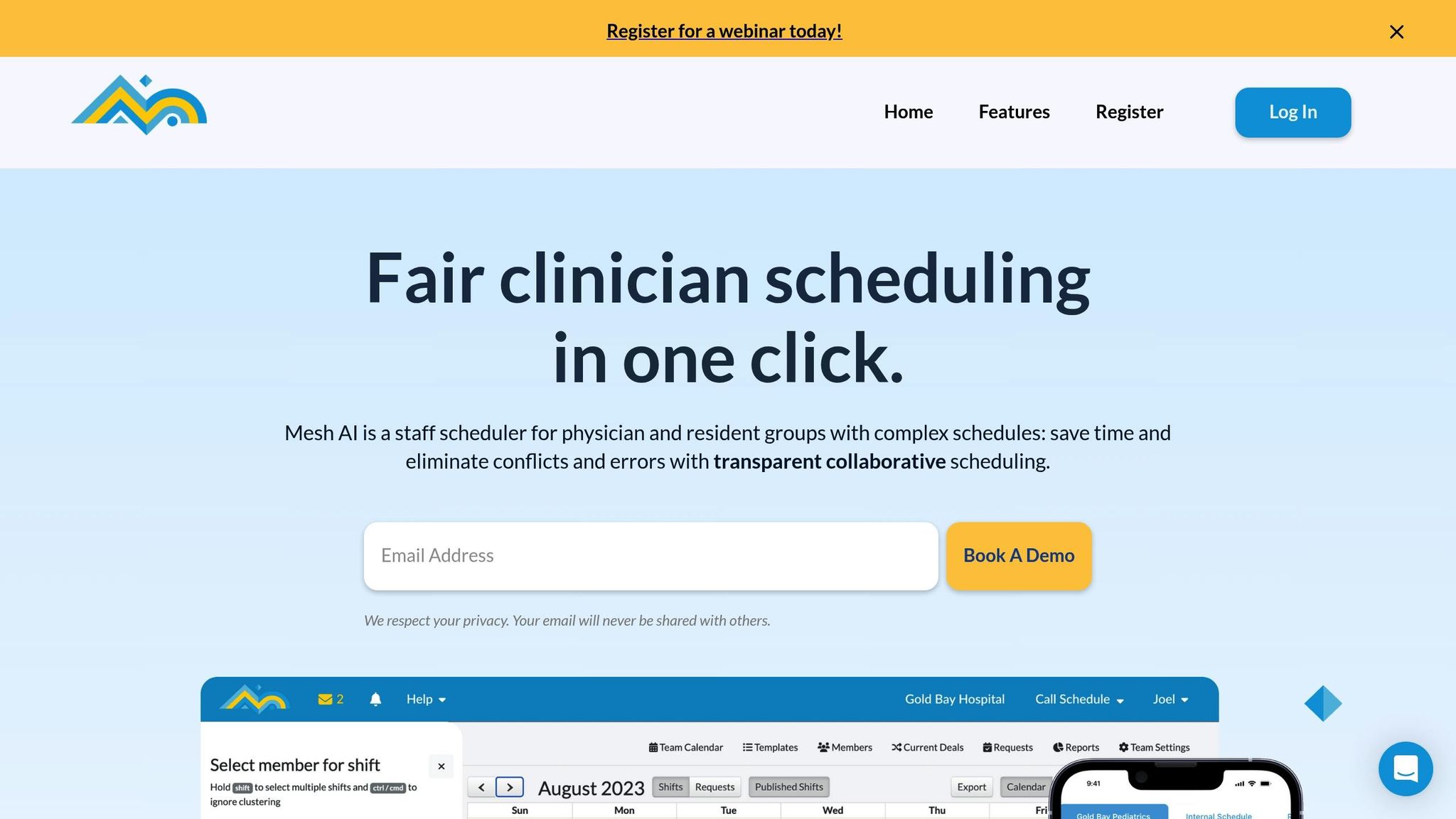
Mesh AI is an advanced scheduling platform powered by artificial intelligence, designed to streamline employee scheduling by analyzing business data and providing smart solutions to common challenges.
AI-powered scheduling automation
Mesh AI uses a predictive scheduling engine that processes historical data and external factors to create efficient schedules. It doesn’t just automate the process - it also aligns schedules with employee preferences, ensuring a balance between operational needs and workforce satisfaction.
The platform’s demand forecasting feature adjusts staffing levels based on customer traffic patterns and seasonal trends. It even responds to sudden changes in real time, making it a dynamic tool for managing unpredictable situations.
Staying compliant with U.S. labor laws
Beyond automation, Mesh AI helps businesses stay on top of labor regulations. It keeps track of work hours, mandated breaks, and required rest periods, sending alerts to managers when schedules need to be adjusted to meet compliance standards.
Seamless integration with HR and payroll tools
Mesh AI connects effortlessly with popular HR and payroll systems, syncing employee information and timesheet data automatically. This integration eliminates the need for manual data entry, ensuring that scheduling, time tracking, and payroll processes run smoothly and consistently.
Flexible for businesses of all sizes
Thanks to its modular design, Mesh AI can adapt to the needs of small businesses and large enterprises alike. Its cloud-based infrastructure supports growth and handles peak scheduling demands, offering centralized management with the flexibility to customize schedules locally as needed.
2. RosterLab
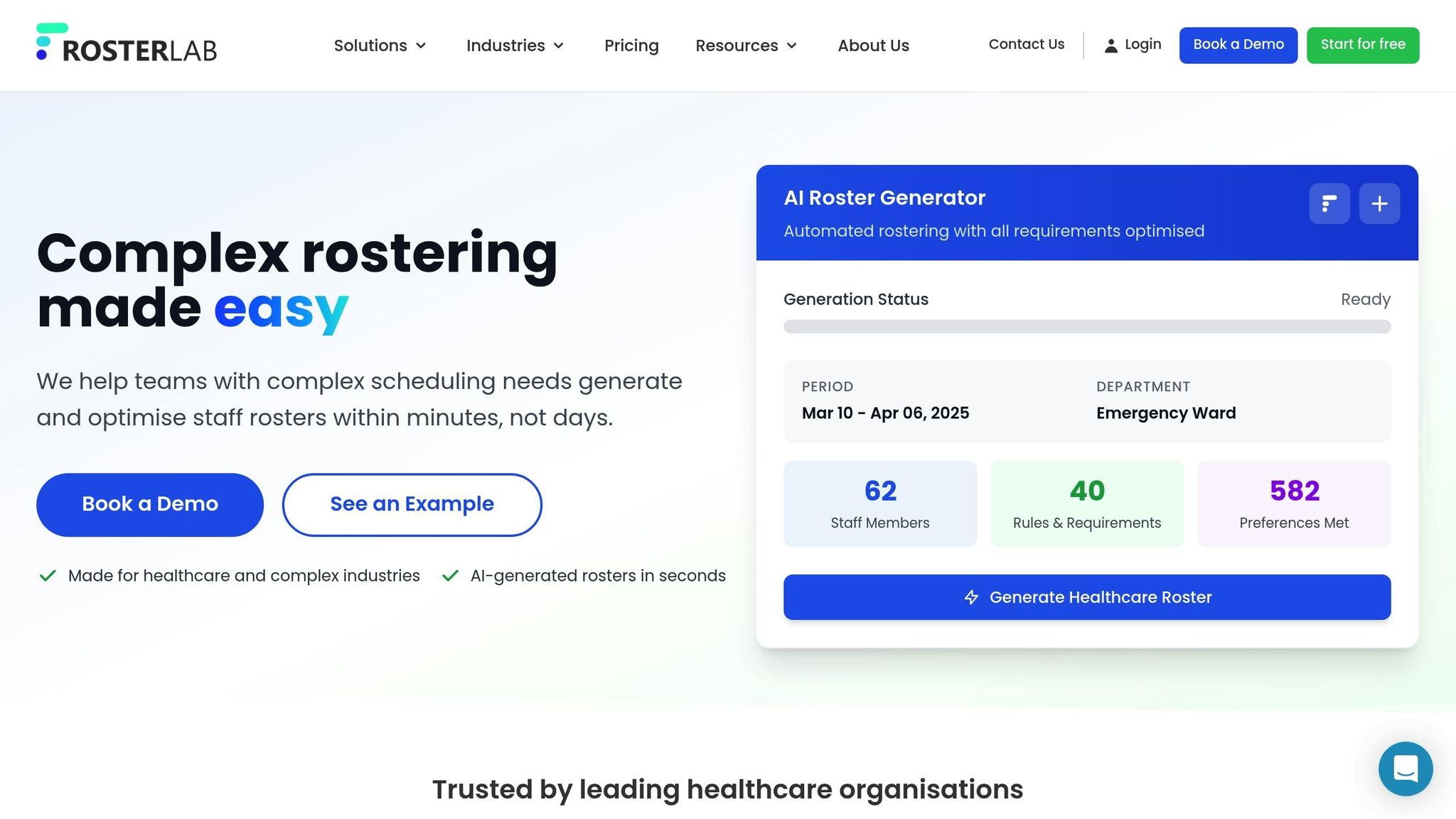
RosterLab takes AI-powered scheduling to the next level, catering to the unique challenges of industries like healthcare and emergency services. By transforming days of manual scheduling into just minutes, it simplifies complex workforce management tasks.
AI-driven scheduling automation
At its heart, RosterLab uses a cutting-edge optimization engine powered by AI algorithms. This system juggles thousands of variables - like staff preferences, operational needs, skill requirements, contract terms, and coverage demands - to craft schedules that work seamlessly.
What sets RosterLab apart is its ability to manage highly intricate scheduling scenarios that would overwhelm simpler tools. It goes beyond merely filling time slots. Instead, it creates schedules designed to be safe, fair, and adaptable, all while meeting operational demands. This makes it particularly valuable for industries where staffing impacts both efficiency and compliance, such as healthcare and emergency services.
Compliance with U.S. labor laws
One of RosterLab's standout features is its built-in enforcement of regulatory and union rules. By integrating these constraints into its algorithms, the system ensures every schedule complies with labor laws and union agreements right from the start. For heavily regulated industries like healthcare, this automated compliance reduces the risk of costly fines and disruptions caused by labor law violations.
Integration with HR and payroll systems
RosterLab integrates seamlessly with Trendcare and can be customized to work with other payroll systems. This flexibility allows organizations to keep their existing HR and payroll setups while enjoying the benefits of advanced AI scheduling. The system synchronizes data effortlessly, handling employee information, schedules, and time tracking with ease.
Scalable for businesses of all sizes
The platform’s robust optimization engine is designed to scale, whether you’re managing a small department or a large, multi-location organization. With four deployment options available, businesses can choose the setup that best matches their needs. RosterLab adapts to the complexity of any operation, delivering optimized schedules while maintaining compliance and efficiency, no matter the size or scope.
3. Zendesk
Zendesk stands out as a powerhouse in customer support management. While it’s not primarily a scheduling tool, its automation features and real-time analytics provide valuable insights for staffing decisions by analyzing inquiry volumes. The platform is also highly scalable, making it suitable for everything from small teams to large-scale contact centers. Plus, with a wide range of integrations, it simplifies and streamlines daily operations.
4. Humanity Schedule
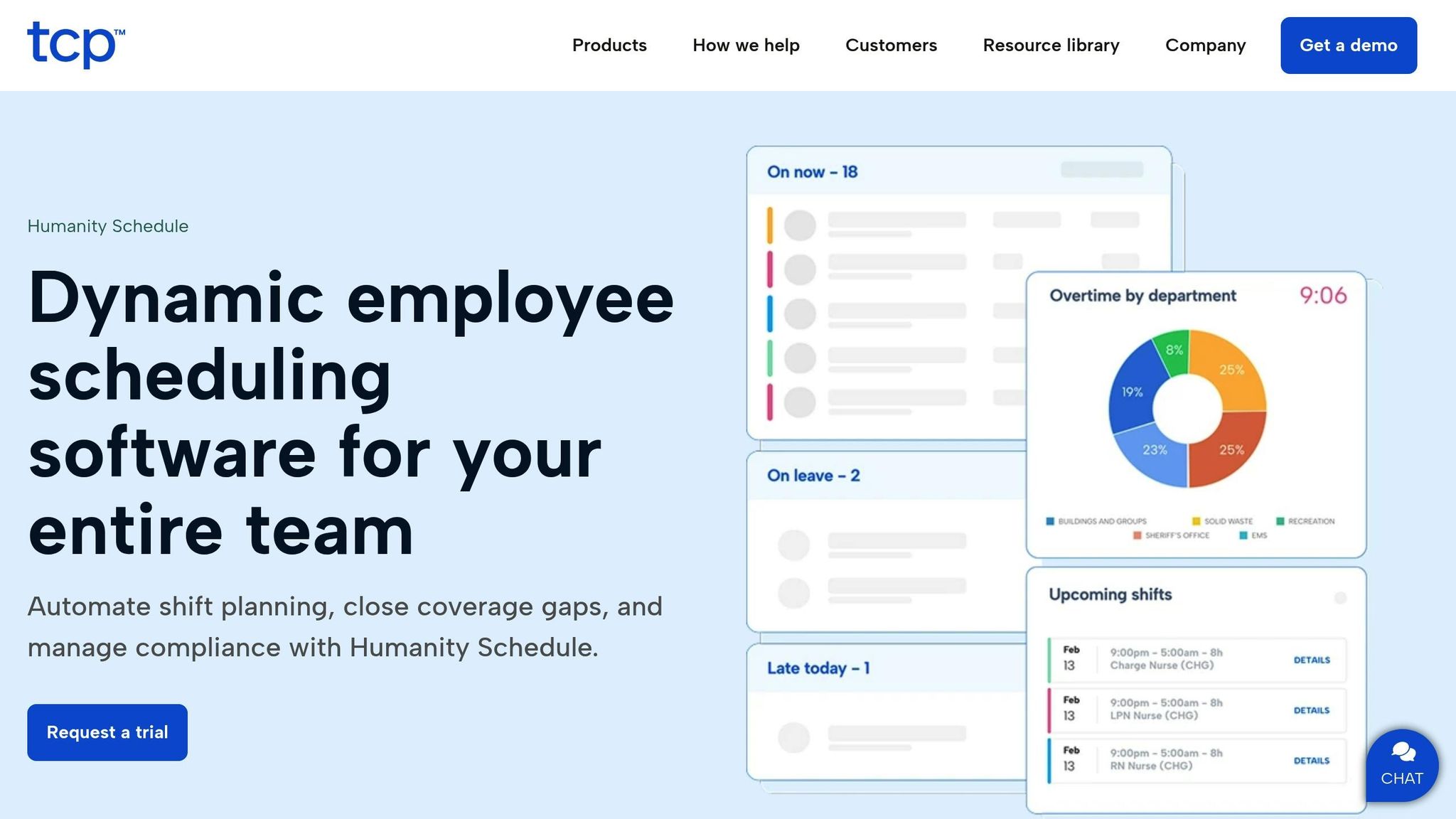
Humanity Schedule offers AI-powered tools to simplify and automate complex scheduling tasks, making it a valuable solution for businesses navigating intricate workforce management challenges. By leveraging machine learning, this platform not only optimizes shift planning but also ensures schedules comply with labor laws and organizational policies.
AI-driven Scheduling Automation
The platform's machine learning capabilities analyze past scheduling decisions and employee performance to predict the most efficient shifts and staffing requirements. This automation helps streamline workforce planning while reducing the manual effort involved in creating schedules.
Adherence to U.S. Labor Laws
Humanity Schedule features a robust rules engine designed to prevent scheduling conflicts by checking against labor laws, internal policies, and union agreements. It automatically flags and avoids issues like missed meal breaks, overtime violations, and child labor restrictions. Additionally, businesses can customize rules to address specific needs, such as skill certifications or licensing requirements. This ensures conflicts like overlapping shifts, availability mismatches, and hour limits are identified and resolved proactively.
Integration with HR and Payroll Systems
To maintain transparency and compliance, Humanity Schedule keeps detailed, audit-ready logs of all scheduling actions, edits, and updates. Managers receive real-time alerts for potential compliance issues, such as excessive hours, missed breaks, or overlapping shifts. By integrating with HR and payroll systems, the platform strengthens overall workforce management, aligning scheduling with broader business goals.
Flexible for Businesses of All Sizes
Humanity Schedule adapts seamlessly to businesses ranging from small teams to large, multi-location enterprises. Its localized compliance templates embed region-specific labor rules directly into the scheduling process, simplifying management for organizations operating across multiple jurisdictions.
5. Deputy
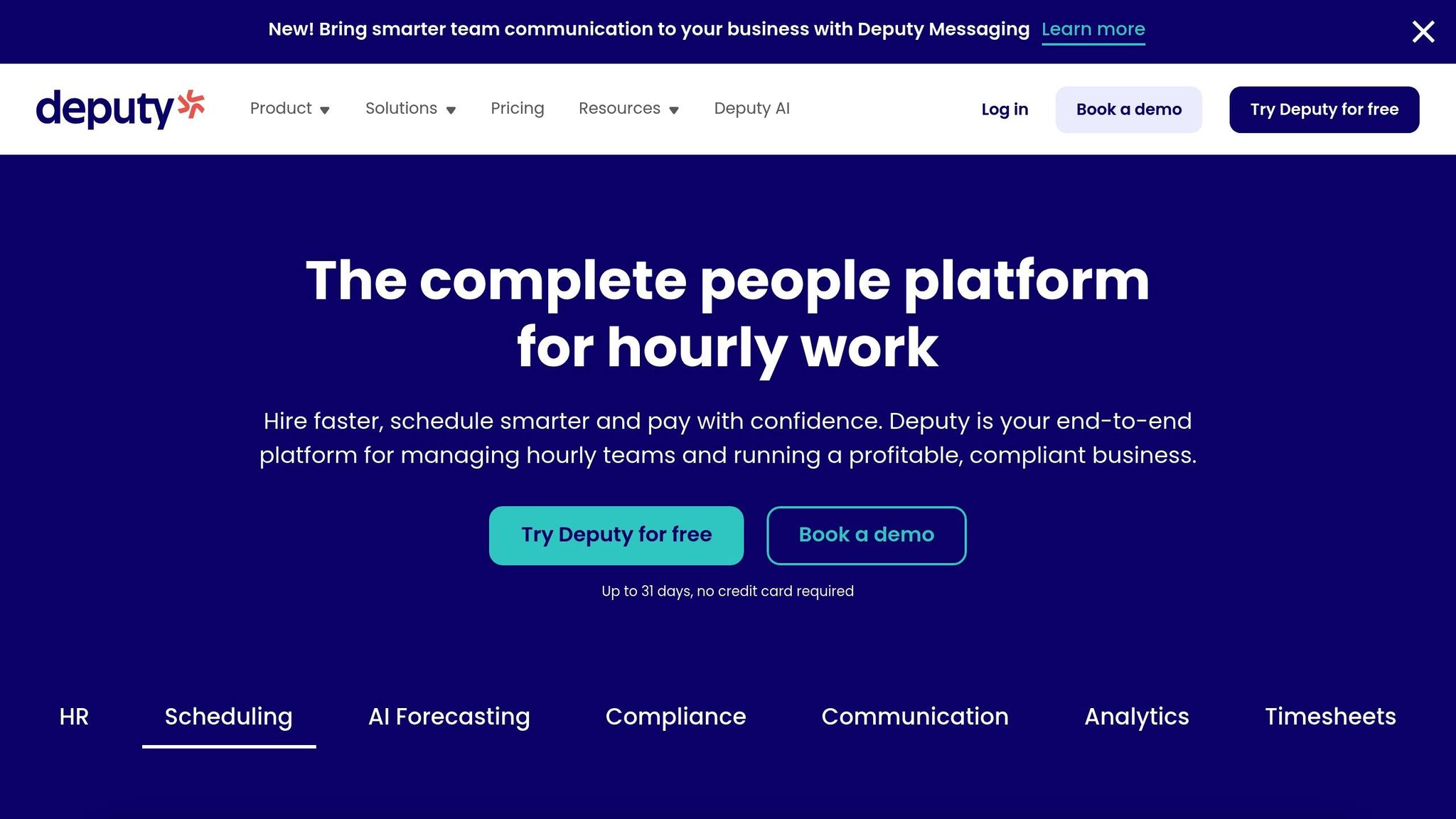
Deputy is a workforce management platform that combines AI-powered scheduling tools with practical features to help businesses manage their staff more effectively. By automating scheduling and ensuring compliance with labor laws, it simplifies operations for companies across various industries and locations.
AI-Powered Scheduling
Deputy uses AI to analyze historical trends, employee availability, and business needs to create efficient shift schedules. This helps businesses avoid the pitfalls of overstaffing or understaffing by matching the right number of employees to the demands of the business at any given time.
The scheduling system takes into account a variety of factors, such as employee skills, certifications, preferred hours, and labor costs. It even prioritizes workers based on their availability, performance, and cost-effectiveness. This level of detail ensures that schedules are not only efficient but also fair and cost-conscious.
Staying Compliant with U.S. Labor Laws
Deputy helps businesses navigate the complexities of labor laws by automatically checking schedules for compliance with federal, state, and local regulations. It flags issues like missed breaks, excessive overtime, or insufficient rest periods between shifts. For companies operating in multiple states, Deputy adjusts to the specific labor laws of each location.
The platform also offers a compliance dashboard that sends real-time alerts about potential violations, giving managers the chance to fix problems before they escalate. Additionally, it keeps detailed records of scheduling changes and approvals, making compliance reporting more straightforward.
Seamless Integration with Payroll and HR Systems
Deputy integrates smoothly with popular payroll and HR tools like QuickBooks, ADP, and BambooHR. It syncs time tracking data directly to payroll systems, eliminating the need for manual data entry and ensuring accurate pay based on actual hours worked.
The platform captures clock-in and clock-out data through mobile apps, web browsers, or physical kiosks, giving managers a clear view of attendance and labor costs. This real-time data flow enhances efficiency and accuracy across the board.
Flexible for Businesses of All Sizes
Whether you're running a small retail store or managing a large enterprise, Deputy adapts to your needs. It offers multi-location management and flexible pricing plans, making it suitable for businesses of any size.
Small businesses can start with basic tools like scheduling and time tracking, while larger organizations can add features like performance management, task tracking, and analytics as their needs grow. Its cloud-based design ensures reliable performance, no matter how many users or locations are involved.
6. 7shifts

7shifts is a scheduling platform tailored specifically for the restaurant industry. It provides tools designed to help businesses stay compliant with U.S. labor laws and Fair Workweek regulations. This focus on industry-specific needs makes 7shifts stand out from more general scheduling software.
One of its standout features is overtime alerts, which notify managers when employees are nearing or exceeding overtime limits. Managers can also set custom thresholds to better manage labor costs and avoid employee burnout.
Another helpful tool is its custom break management system. This feature ensures that mandatory or flexible break schedules are followed, with breaks categorized as paid or unpaid in line with FLSA guidelines. To further ensure compliance, the platform includes a break attestation tool, prompting employees to confirm they’ve taken their scheduled breaks.
sbb-itb-212c9ea
7. When I Work
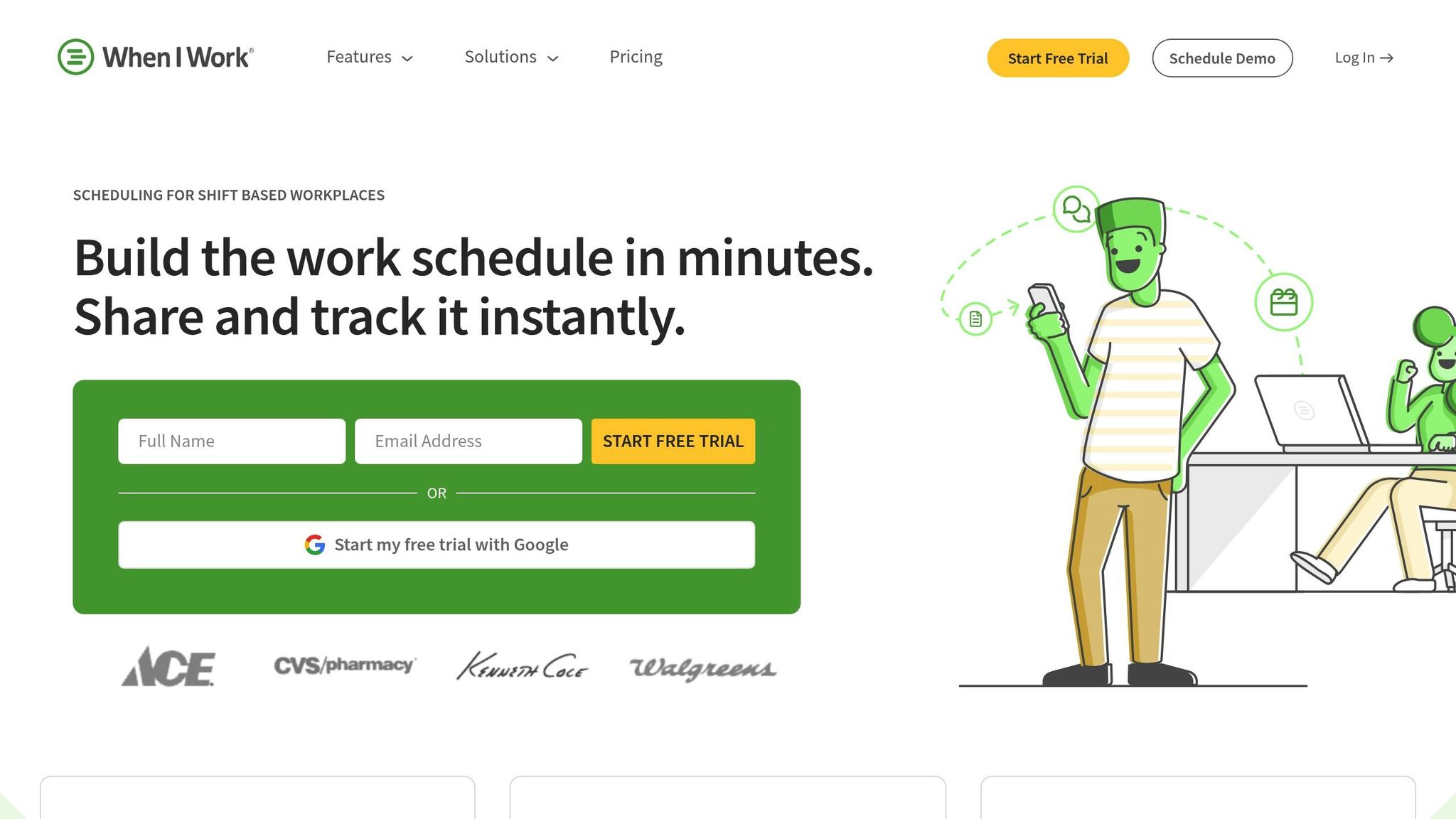
When I Work is a scheduling platform tailored for shift-based businesses like restaurants and retail. With an impressive 9.6/10 Editor's Rating, it stands out for its well-rounded approach to managing schedules efficiently. Let’s dive into how its seamless integration with HR and payroll systems boosts productivity.
Integration with HR/Payroll Systems
When I Work shines in its ability to connect with widely-used business systems, simplifying operations and reducing manual work. Business News Daily rated its integration features 9.4/10, highlighting its robust connectivity.
"When I Work can integrate with some of the most popular payroll, point-of-sale and business operations platforms. Its payroll integrations include Gusto, Run by ADP, ADP Workforce Now, Gig Wage, OnPay, Paychex, QuickBooks Online and SimplePay." - Business News Daily
By automatically syncing employee details and time entries with payroll systems, the platform helps minimize errors and speeds up payroll processing.
| Payroll System | Key Features | Functionality |
|---|---|---|
| ADP Workforce Now | Full bidirectional sync | Send hours, pay rates, PTO; create users from ADP |
| Square Payroll | Complete employee sync | Sync employees, schedules, and time entries (US only) |
| RUN Powered by ADP | Pay period integration | Send worked hours for pay periods |
| Gusto | Time tracking export | Export time and attendance data |
Scalability for Different Business Sizes
In addition to its strong integration capabilities, When I Work is built to adapt to the needs of businesses as they grow. It’s particularly suited for industries like restaurants and retail, where managing complex schedules and staying compliant with labor laws are top priorities. As businesses expand, the platform scales seamlessly, offering integrations not just with payroll systems but also with point-of-sale platforms and automation tools like Zapier. This flexibility allows companies to design workflows that match their unique needs.
When I Work focuses on delivering reliable, high-quality integrations, making it a trusted choice for growing shift-based businesses.
8. Connecteam
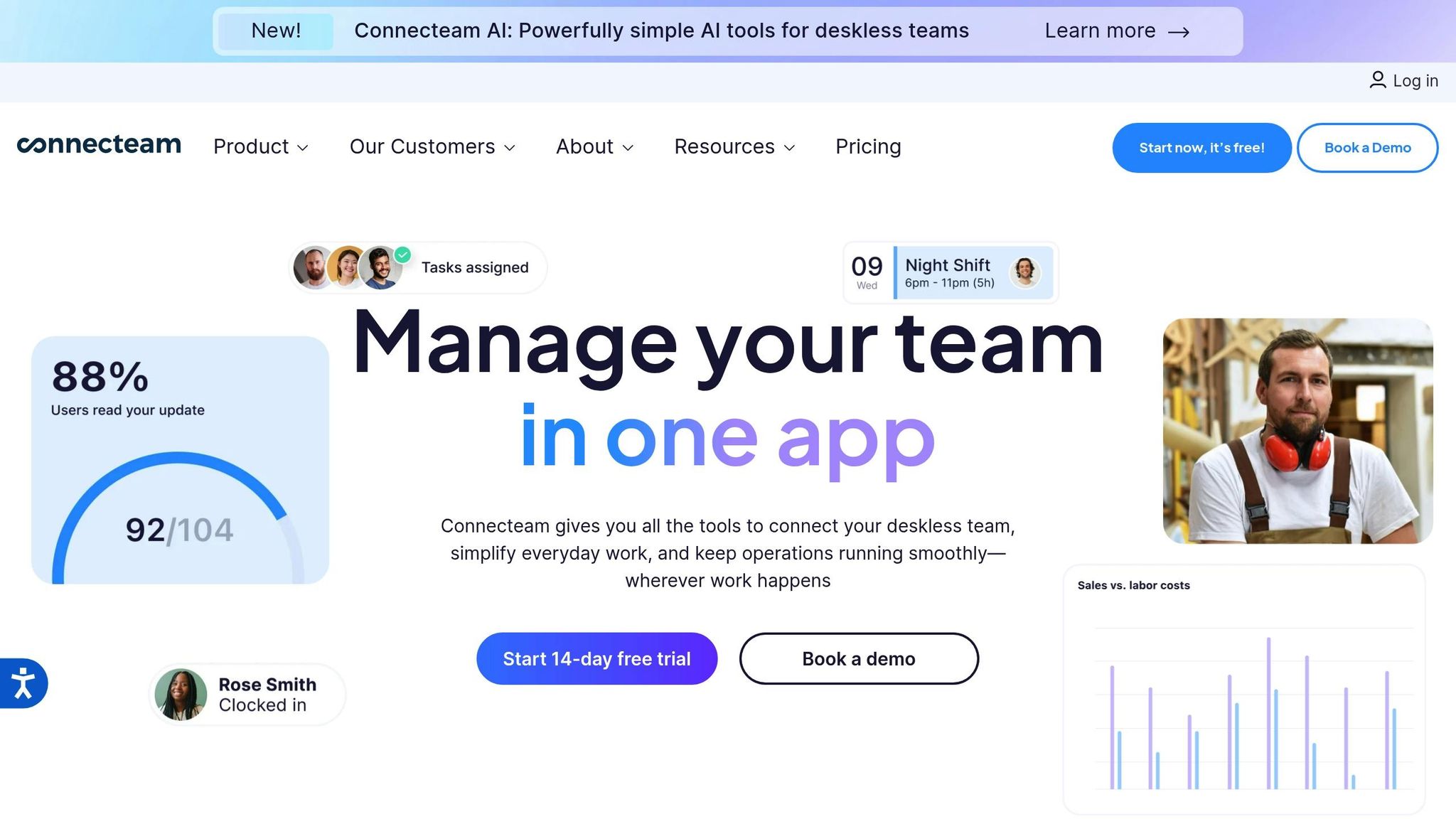
Connecteam is a platform designed to streamline workforce scheduling and business management, specifically catering to deskless workers and field teams. It’s particularly suited for industries like construction, healthcare, retail, and hospitality.
AI-driven Scheduling Automation
Connecteam simplifies scheduling with its auto-scheduling feature, which takes into account employee availability, skill sets, and associated costs to craft efficient schedules. This automation significantly reduces the time spent on manual scheduling.
The platform learns from previous scheduling patterns and preferences, improving its suggestions over time. It also flags and resolves conflicts automatically, ensuring smoother operations. For recurring shifts, Connecteam makes it easy to establish weekly or monthly patterns that adapt to evolving business needs. Additionally, its forecasting tools help businesses predict staffing requirements by analyzing historical data and seasonal trends.
Compliance with U.S. Labor Laws
Staying compliant with federal and state labor laws is critical, and Connecteam helps businesses navigate these regulations effortlessly. The platform includes built-in compliance checks, automatically calculating overtime in line with FLSA standards to ensure employees are compensated correctly for hours worked beyond 40 in a week.
It also tracks break and meal period requirements, which vary by state, and sends notifications when employees are nearing mandatory break times. By automatically adapting to different state regulations, Connecteam minimizes the risk of non-compliance and the costly penalties that can follow.
For added accountability, the platform maintains detailed audit trails of scheduling changes, time entries, and approvals. These records are invaluable during compliance audits or labor disputes, offering clear documentation of decisions and actions.
Scalability for Different Business Sizes
Connecteam’s flexibility makes it a fit for businesses of all sizes, from startups to large enterprises. Its multi-location management capabilities let businesses create location-specific schedules while keeping a centralized overview.
For growing companies, Connecteam offers a modular approach. Businesses can start with basic scheduling features and gradually add tools like project management, training modules, and advanced reporting as their needs evolve. The platform supports unlimited locations and can handle complex organizational structures with multiple departments, roles, and permission levels.
Smaller businesses benefit from its easy setup and user-friendly interface, while larger organizations can utilize advanced features like custom workflows. With pricing that adjusts based on usage, Connecteam provides a cost-effective solution for businesses at any stage of growth.
9. QuickBooks Time
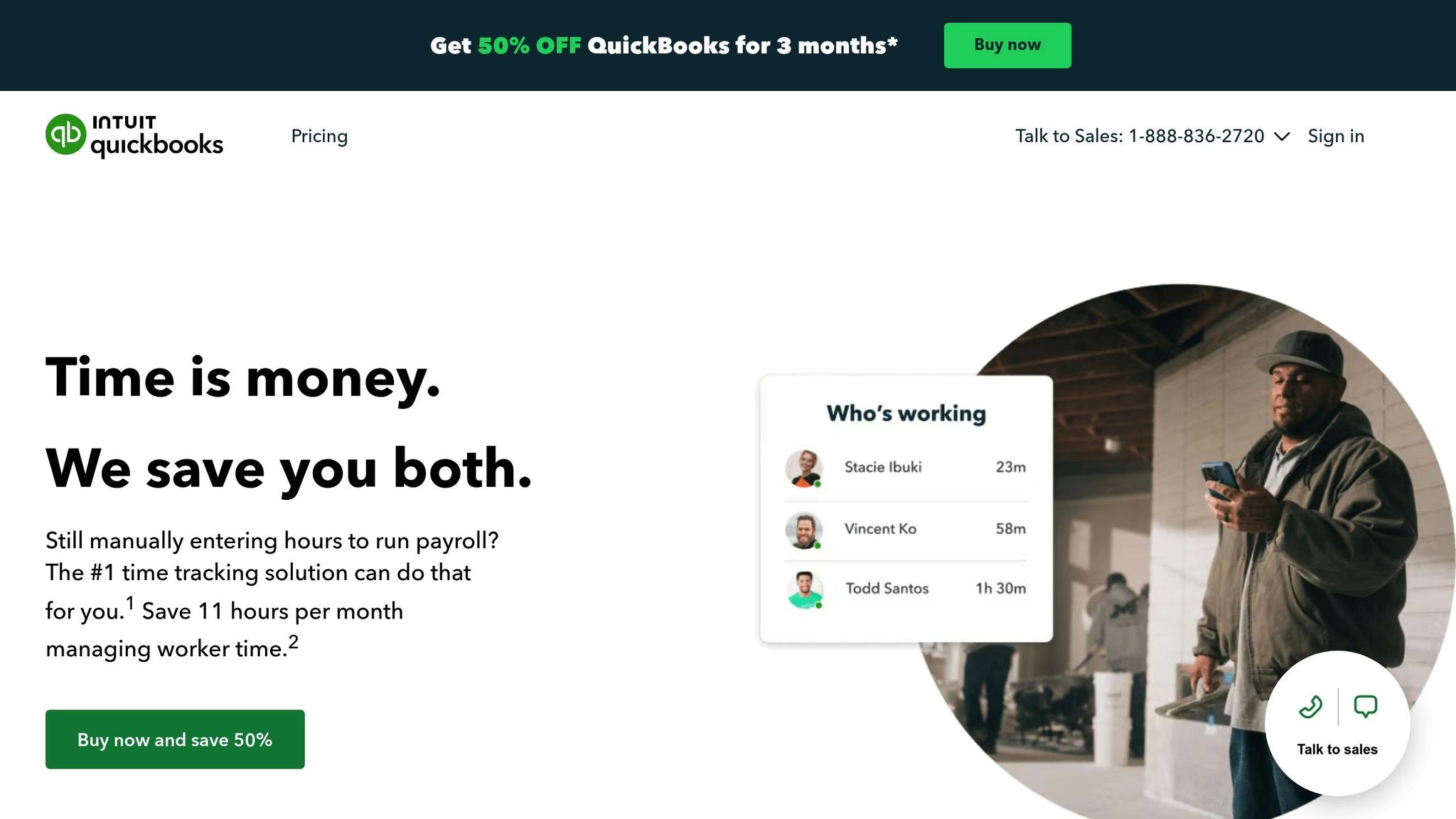
QuickBooks Time, previously known as TSheets, is a time tracking and scheduling tool that works seamlessly with QuickBooks accounting software. It’s designed to meet the needs of various industries, like construction, retail, field services, and professional services. Let’s take a closer look at some of its standout features that make scheduling easier and help businesses stay compliant.
Smarter Scheduling with Automation
QuickBooks Time uses automation to simplify shift scheduling. By analyzing historical data and employee availability, it assigns shifts efficiently. It also provides alternative options when conflicts arise and offers recurring templates that adapt to changing project demands.
Staying on Top of Labor Laws
The platform helps businesses meet federal and state labor laws by monitoring overtime and breaks in real time. It also keeps detailed time records and adjusts for specific regulations unique to each state.
Seamless HR and Payroll Integration
QuickBooks Time integrates directly with QuickBooks Payroll and other business tools, ensuring that data flows smoothly and reducing the time spent on administrative tasks.
Designed for Businesses Big and Small
Whether you’re running a small business or managing a large enterprise, QuickBooks Time has you covered. It offers multi-location management, centralized reporting, advanced security options, and flexible pricing plans to suit businesses of all sizes.
10. Sling

Sling delivers a robust solution for shift-based businesses looking to simplify scheduling, manage time tracking, and improve team communication. Designed for industries like restaurants, retail, and healthcare, this platform uses smart algorithms to streamline scheduling while keeping teams informed and connected.
AI-powered Scheduling Made Simple
With Sling, scheduling becomes a breeze. The platform evaluates employee availability, skills, and labor costs to create optimized schedules in seconds. It learns from past data to assign shifts efficiently and quickly identifies alternative options when conflicts arise.
Sling’s auto-scheduling tools also take into account certifications, preferred working hours, and budget limits. This means managers can skip the usual back-and-forth of manual scheduling. Recurring schedule templates are adaptable to seasonal trends and business demands, saving even more time.
Beyond efficiency, Sling ensures that schedules comply with labor regulations, helping businesses avoid legal headaches.
Staying Compliant with U.S. Labor Laws
Sling keeps a close eye on federal and state labor laws, ensuring adherence to rules around overtime, breaks, and rest periods. It alerts managers to potential compliance risks, so they can act before issues arise.
The platform also maintains detailed records of scheduling decisions and time tracking, creating a reliable audit trail for inspections. It even accommodates specific laws like predictive scheduling requirements in cities such as San Francisco and Seattle, which mandate advanced notice for any schedule changes.
Seamless Integration with HR and Payroll Systems
Sling doesn’t just stop at scheduling - it also integrates smoothly with payroll systems like ADP, Paychex, and QuickBooks, making time tracking and payroll processing hassle-free. It can connect to point-of-sale systems to adjust staffing levels based on real-time sales data.
The platform extends its integrations to HR functions, including benefits administration and onboarding. For example, new hire details sync automatically, and schedule data can inform benefits calculations based on hours worked. This reduces administrative work and ensures accuracy across your business operations.
Designed to Grow with Your Business
Whether you’re running a small business or managing a large enterprise, Sling adapts to your needs. For companies with multiple locations, it offers centralized management tools that allow corporate teams to oversee operations while giving local managers control over day-to-day scheduling.
Larger organizations can take advantage of advanced features like detailed reporting dashboards, custom user permissions, and dedicated account support. Meanwhile, small businesses benefit from an intuitive interface and budget-friendly pricing that scales as their needs evolve. With its mobile-first design, Sling ensures that managers and employees can access scheduling tools on the go, making it especially useful for remote and field-based teams.
Tool Comparison Table
Here's a quick overview of some of the top AI scheduling tools and their standout features. Use this table to identify which tool aligns best with your needs:
| Tool | Key Features |
|---|---|
| Mesh AI | Predictive scheduling and optimization tools |
| RosterLab | Streamlined shift planning and compliance focus |
| Zendesk | Workload management with performance analytics |
| Humanity Schedule | Automated scheduling paired with cost controls |
| Deputy | Scheduling, time tracking, and mobile access |
| 7shifts | Tailored for restaurants with forecasting tools |
| When I Work | Designed for small to medium-sized teams |
| Connecteam | Field management with task automation features |
| QuickBooks Time | Project scheduling with payroll integration |
| Sling | Simplified scheduling and team communication |
For the most up-to-date information, check each tool's website. Pick the one that best matches your workflow and goals.
How to Pick the Right AI Workforce Scheduling Tool
Selecting an AI workforce scheduling tool isn’t just about finding the latest tech - it’s about identifying a solution that aligns with your business’s specific needs. The wrong choice can lead to compliance issues, unhappy employees, and inefficiencies that hurt your bottom line.
Here’s what to focus on when making your decision:
Tailor the tool to your industry. Every sector has unique scheduling challenges, and a one-size-fits-all approach rarely works. For example, retail businesses need tools that predict peak hours using sales data, while hospitality relies on real-time adjustments based on bookings. Healthcare organizations must ensure staff certifications are tracked and patient care remains uninterrupted. Educational institutions face the added complexity of managing various staff types and navigating union agreements.
Look for automatic compliance updates. Staying compliant is non-negotiable, especially in regulated industries where mistakes can lead to hefty fines. The right tool should have built-in compliance logic, flag potential violations in real time, and provide documentation for audits. Make sure it addresses the specific regulations that apply to your sector.
Check integration capabilities. A good scheduling tool should work seamlessly with your existing systems, like HR platforms, payroll software, and time-tracking tools. If integration is clunky or incomplete, you could end up creating more work instead of saving time.
Keep your organization’s size and complexity in mind. As your team grows, so does the need for more sophisticated scheduling solutions. Larger organizations require tools that can handle complex scheduling scenarios, while smaller teams might benefit from simpler, more cost-effective options.
Insist on transparency in AI decisions. Employees and managers need to trust the system. Choose a tool that explains its scheduling decisions, highlights potential rule conflicts, and allows for human overrides. Transparency encourages buy-in and smooth adoption.
Don’t overlook mobile accessibility. For frontline teams, mobile access is crucial. Employees should be able to check schedules, request time off, and swap shifts through an app. Managers also need the flexibility to make adjustments on the go. Without solid mobile functionality, you risk pushback from your workforce.
Ensure data quality before implementation. AI tools are only as good as the data they work with. Clean and accurate information - like employee details, historical schedules, and operational metrics - is essential for effective scheduling. Address any gaps or inconsistencies before rolling out the tool.
Lastly, prioritize security and privacy. Protecting sensitive employee and scheduling data is critical, especially if your organization operates across multiple locations or departments.
Conclusion
AI-powered workforce scheduling has shifted from being a luxury to an essential tool, turning the tedious task of manual scheduling into a faster, more efficient process. The ten solutions discussed in this article highlight how artificial intelligence is reshaping business operations.
The numbers speak for themselves: 78% of organizations now use AI for at least one business function, up from 55% in 2023. When it comes to workforce scheduling, managers using AI tools report cutting scheduling time by as much as 80%. This leap in efficiency directly translates to better resource management and cost savings.
One of the clearest advantages is cost savings and compliance protection. Companies leveraging generative AI often see measurable reductions in operational costs. Additionally, AI tools automatically enforce labor laws and internal policies, significantly reducing the risk of non-compliance - a critical safeguard for businesses navigating complex regulations across multiple states or countries.
AI systems also improve over time. By analyzing historical trends, seasonal fluctuations, employee preferences, and real-time business needs, these tools refine their predictions, ensuring schedules remain highly accurate even as your business evolves. This adaptability eliminates the need for constant manual adjustments.
Another game-changer is improved employee satisfaction, which has a ripple effect across the organization. Workers benefit from more predictable schedules, fairer shift distributions, and easier shift swapping. Happier employees are less likely to leave, which helps lower turnover rates and enhances overall efficiency.
From Mesh AI's predictive analytics to Sling's user-friendly mobile design, the tools available today showcase the potential of AI in workforce scheduling. However, the key is finding a solution that aligns with your industry, team size, and compliance requirements. Even the most advanced tool won’t deliver results if it doesn’t suit your business’s specific needs.
As AI technology continues to evolve, these tools will only become more powerful and accessible. Early adopters are already reaping the rewards - lower labor costs, better compliance, and happier employees. The real question is whether your organization will seize this opportunity or risk falling behind.
For businesses still clinging to manual scheduling, the competitive gap widens with each passing day. The tools are here, proven, and increasingly affordable. Choosing the right AI scheduling solution can be the step that secures your business’s edge in the market.
About AI Apps
When it comes to choosing the right workforce scheduling tools, the process can feel daunting. That’s where AI Apps steps in. This platform serves as a centralized hub, offering a curated directory of over 1,000 AI tools spanning various categories.
One of its standout features is the advanced filtering system, designed to save U.S. businesses time and effort. You can sort tools by category, sub-category, and pricing model, making it easier to zero in on the solutions that fit your specific needs. Whether you’re searching for workforce scheduling software, automation tools, or other business applications, this system simplifies the evaluation process.
What makes AI Apps especially trustworthy is its multi-step verification process. Every tool listed undergoes rigorous checks to ensure quality, functionality, and reliability before being added to the directory. This process ensures that businesses can confidently explore tools that meet high standards. Additionally, the platform highlights both featured and newly launched tools, providing access to cutting-edge solutions as they hit the market.
For companies exploring AI-driven workforce scheduling tools, AI Apps offers a comprehensive comparison feature. This allows businesses to easily compare features and pricing models, ensuring they make informed decisions. Beyond workforce scheduling, the platform covers a wide range of AI tools, from text generators to video editing software, making it a go-to resource for businesses looking to integrate AI across various departments.
To keep users informed, AI Apps also includes a blog focused on the latest trends in AI and workforce management. This resource ensures businesses stay up-to-date with advancements in workforce technology. By combining tool discovery with educational content, AI Apps supports U.S. companies navigating the fast-changing AI landscape, making it a valuable ally in the decision-making process.
FAQs
How do AI scheduling tools help businesses comply with U.S. labor laws?
AI-driven scheduling tools play a key role in helping businesses navigate U.S. labor laws by streamlining processes and minimizing mistakes. These tools often come equipped with features like tracking employee hours, ensuring shifts are distributed fairly, and adhering to overtime rules. Many systems also offer customization options to meet specific state or local labor requirements.
Using real-time data and predictive analytics, these tools can identify potential compliance issues - such as employees working beyond allowed hours or missing legally required breaks. This allows employers to address problems before they escalate, reducing the risk of legal penalties and supporting fair, efficient scheduling.
What should businesses look for in an AI workforce scheduling tool?
When selecting an AI workforce scheduling tool, it’s important to focus on a few critical aspects to ensure it aligns with your business needs. Start by checking if the tool can integrate smoothly with your current systems. This will save you headaches down the line. Also, make sure it includes robust data security features and complies with labor regulations to steer clear of potential legal complications.
Another key consideration is whether the tool can handle team growth as your business expands. It should also be capable of creating schedules that balance workload demand with employee preferences. By focusing on fairness and efficiency, you’ll not only boost productivity but also create a scheduling process that keeps your team happy and engaged.
How can AI scheduling tools boost employee satisfaction and reduce turnover?
AI scheduling tools play a key role in improving employee satisfaction by crafting equitable and consistent schedules that take individual preferences into account. This approach supports a healthier balance between work and personal life, easing stress and helping to prevent burnout, which contributes to a more supportive and uplifting workplace atmosphere.
Beyond scheduling, these tools also examine workforce data to spot trends and anticipate potential risks of employee turnover. With this information, businesses can tailor schedules and engagement efforts to better meet employee needs. The result? Greater job satisfaction, deeper loyalty, and a noticeable reduction in turnover rates.
